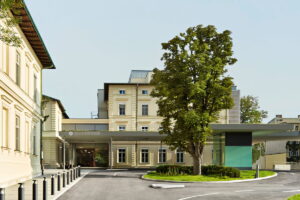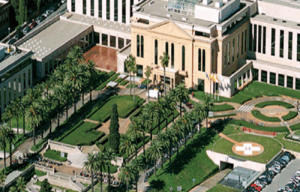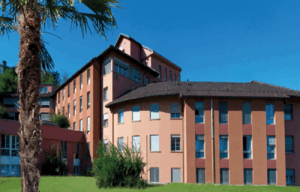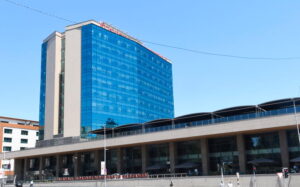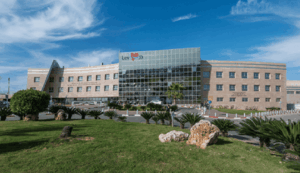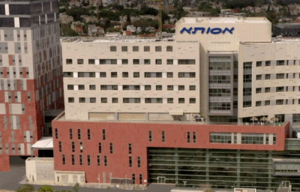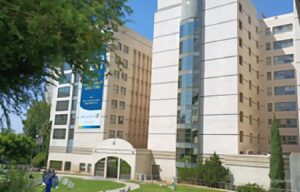Facial birthmarks
“Birthmarks” or “moles” are common lay terms for nevi, which are benign neoplasms composed of pigmented cells. The color of nevi can range from light to dark brown, and their size may vary from 0.5 cm to several centimeters. In some cases, a birthmark may cover a significant area of the body.
According to statistical data, approximately 90% of all moles form before the age of 25-30. Congenital nevi account for no more than 5% of cases. The causes of mole formation include heredity, exposure to ultraviolet radiation (sunlight), skin trauma, and hormonal changes.
Classification of nevi by structure:
- Lentigo — flat pigmented spots
- Epidermal-dermal nevi — flat or slightly raised above the skin surface
- Compound nevi — dark-colored and elevated above the skin
- Intradermal nevi — often with a hairy or verrucous (warty) surface
- Halo nevi (Sutton’s nevi) — surrounded by a halo of depigmented skin
- Dysplastic nevi — with irregular borders and varied pigmentation
Symptoms indicating the need for diagnosis and treatment
If a mole does not cause discomfort and remains unchanged over time, removal is not necessary. However, facial moles can be a source of aesthetic discomfort and may therefore require removal.
You should consult a dermatologist if you have:
- Fair skin that burns easily in the sun
- Numerous moles (more than 50)
- Large congenital nevi
- A family history of melanoma
- History of sunburns during childhood
- Frequent trauma to birthmarks due to contact
Diagnostic and treatment methods
Diagnosis
To examine birthmarks, dermatologists at leading international clinics perform dermatoscopy using a special instrument called a dermatoscope, which provides a 10x magnified image. Doctors pay close attention to the appearance, shape, size, color, and internal structure of the mole.
Treatment
Before removing a nevus, it is essential to confirm that it is not malignant. Only after a thorough examination and dermatoscopy can a specialist determine whether a birthmark is safe to remove.
How are facial moles removed?
- Cryodestruction (using liquid nitrogen). Drawback: nitrogen may penetrate deep skin layers.
- Electrocoagulation (burning with electric current). Drawbacks: pain and risk of scarring.
- Radio wave method (removal via high-frequency radio waves). Drawbacks: long recovery period, not suitable for eyelids or mucous membranes.
- Laser — the most advanced method, considered the “gold standard” for mole removal using a laser beam.
Advantages of laser treatment
- The neoplasm is completely removed
- Ultra-precise method — does not affect surrounding tissues
- No scarring after removal
- Painless (can be performed with local anesthesia)
- Bloodless procedure (simultaneous coagulation of blood vessels)
- Removal is completed in a single session
- Fast (takes from a few seconds to a few minutes)
Innovations in global clinics
Top clinics across Europe use expert-level diagnostic systems, such as FotoFinder, for innovative examination of skin neoplasms. The procedure allows for the analysis of all moles on the body in just 60 minutes. The evaluation is performed by artificial intelligence.
Top clinics
-
 Acibadem Altunizade Clinic
Acibadem Altunizade Clinic -
 Ajibadem Atasehir Clinic
Ajibadem Atasehir Clinic -
 Medical Park Antalya Clinic
Medical Park Antalya Clinic -
 Dubai, UAE NMC Healthcare
Dubai, UAE NMC Healthcare -
 Shishli Memorial Clinic.
Shishli Memorial Clinic. -
 Milan, Italy San Raffaele University Hospital
Milan, Italy San Raffaele University Hospital -
 American Hospital Dubai
American Hospital Dubai -
 Leech Private Clinic
Leech Private Clinic -
 Debling Private Clinic
Debling Private Clinic -
 Rudolfinerhaus Private Clinic.
Rudolfinerhaus Private Clinic. -
 Vienna, Austria Wiener Privatklinik (WPK)
Vienna, Austria Wiener Privatklinik (WPK) -
 Clinique Montchoisy
Clinique Montchoisy -
 Clinique La Prairie
Clinique La Prairie -
 Clinique Genolier
Clinique Genolier -
 Ataşehir Memorial Clinic
Ataşehir Memorial Clinic -
 JK Plastic Surgery Center
JK Plastic Surgery Center -
 Barcelona, Spain Medical Center "Teknon"
Barcelona, Spain Medical Center "Teknon" -
 Zurich, Switzerland Hirslanden Clinic
Zurich, Switzerland Hirslanden Clinic -
 Lugano, Switzerland Saint Anna Clinic
Lugano, Switzerland Saint Anna Clinic -
 Geneva, Switzerland Clinique des Grangettes
Geneva, Switzerland Clinique des Grangettes -
 Petah Tikva, Israel Schneider Children's Medical Center
Petah Tikva, Israel Schneider Children's Medical Center -
 Seoul, South Korea Samsung Medical Center
Seoul, South Korea Samsung Medical Center -
 SNUH
SNUH -
 г. Женева, Швейцария Клиника «Женераль-Болье»
г. Женева, Швейцария Клиника «Женераль-Болье» -
 г. Женева, Швейцария Hirslanden Clinique La Colline
г. Женева, Швейцария Hirslanden Clinique La Colline -
 г. Стамбул, Турция Клиника Флоренс Найтингейл
г. Стамбул, Турция Клиника Флоренс Найтингейл -
 г. Рамат-Ган, Израиль Клиника Шиба
г. Рамат-Ган, Израиль Клиника Шиба -
 г. Тель Авив, Израиль Медицинский центр “Ассута”
г. Тель Авив, Израиль Медицинский центр “Ассута” -
 г. Петах-Тиква, Израиль Медицинский центр имени Ицхака Рабина
г. Петах-Тиква, Израиль Медицинский центр имени Ицхака Рабина -
 г. Иерусалим, Израиль Медицинский центр “Хадасса”
г. Иерусалим, Израиль Медицинский центр “Хадасса”






